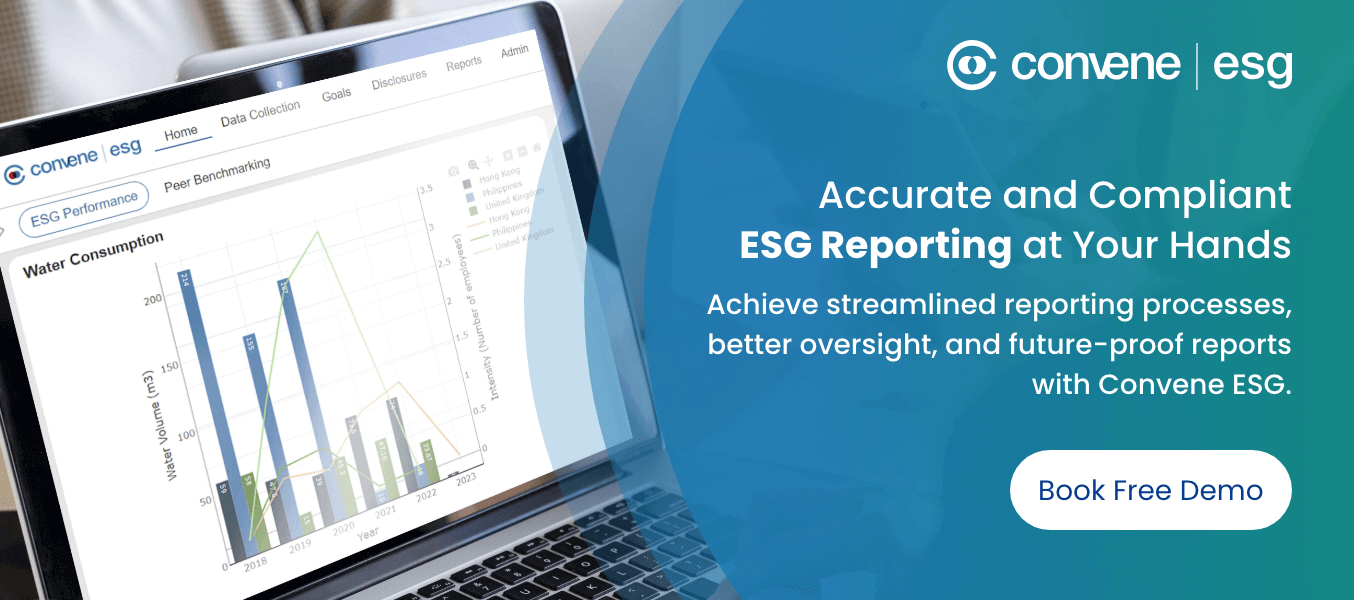Environmental, social, and governance (ESG) reporting provides insights into a company’s dedication to minimising environmental and social impact. Unlike traditional financial metrics that provide bottom-line data points, ESG factors introduce more encompassing topics for measuring the sustainability of a company, such as labour, compensation, equality, energy consumption, and carbon emissions.
The growing public interest in sustainability data became a big reason companies developed ESG scores. These scores simplify benchmarking by converting a company’s entire ESG report into a single number, reflecting its commitment to corporate sustainability.
Want to understand how ESG scores can elevate your value in the market? Our in-depth guide explores ESG scores meaning, why they matter, and best practices to improve a company’s standing.
What are ESG scores?
An ESG score reflects how well a company manages its risks and issues in three key areas: environmental, society, and governance. Expressed through numbers or letter ranking systems, ESG scores are issued by various rating agencies, each with its own methodology and criteria.
Like credit scores, ESG scores provide a benchmark for assessing a company’s performance. Generally, a high score indicates a strong commitment to implementing ethical and effective ESG practices, while those with lower scores have poor and unethical approaches to ESG.
Why do ESG scores matter?
Companies with excellent ESG scores tend to attract more investors, as these scores suggest sustainable investment opportunities backed by strong ESG practices. These scores help investors filter out high-risk investments. This translates to better opportunities when acquiring funds, deepening market penetration, and ensuring long-term sustainability.
ESG Scores vs. ESG Ratings
ESG scores are sometimes referred to as ESG ratings. Often interchanged, both condense complex sustainability data into a simplified format, but they have distinctive features: scores use numbers (e.g., 1-100), while ratings employ letters (e.g., AAA-CCC).
The use of scores versus ratings varies between third-party evaluators. Here’s a list of third-party ranking companies and their ranking systems.
| ESG Scores | ESG Ratings |
|---|---|
| Bloomberg | CDP |
| FTSE | ISS |
| Refinitiv | MSCI |
| RepRisk | S&P Global |
| Sustainalytics |
How are ESG scores calculated?
Calculating ESG scores for companies is not a one-size-fits-all process. Rating agencies are free to conduct calculations based on their own established criteria, but generally, they follow a common framework. Here’s a breakdown of how they typically derive ESG scores.
1. Identify ESG variables
The first phase is to identify important ESG variables for the company being assessed. ESG variables are material factors that affect a company’s ESG performance. The materiality of each variable is based on several factors, including industry, company strategy, and stakeholders’ concerns.
What areas do ESG scores cover? Third-party rating agencies typically check on the following by category:
- Environmental factors – This category deals with the environment and animals. Examples are carbon footprint, energy efficiency, renewable energy use, water usage, pollution, waste management, and biodiversity impact.
- Social issues – This category focuses on business relationships within the company. Under these are labor practices, diversity, human rights, community engagement, and health.
- Governance issues – This category assesses legal, management, and operational matters. This includes board diversity, compensation, shareholder management, risk management and supply chain management, and business ethics.
2. Research and collect ESG data
Rating agencies must then gather pertinent ESG data specific to each variable. This involves conducting independent research, including surveys and site visits. They can also review publicly available materials, such as industry reports, sustainability reports, government databases, and advocacy and annual reports from NGOs.
3. Assign category weight
After data gathering, analysts put ESG weights on each variable based on its materiality to a company. It is important to note that ESG weight is relative depending on the industry and culture of a company.
For example, financial institutions might consider diversity and business ethics more material than carbon emissions. This means the rating agency would place more weight on these factors during their ESG assessment. In contrast, oil companies will likely identify carbon emissions as a more significant factor and assign it a higher weight in their ESG evaluation.
4. Analyse data according to the criteria
This is when rating agencies use scoring models to dissect a company’s ESG performance. Based on their criteria, the agency would generate the scores, considering the weights in their calculations. This systematic approach is repeated for each variable across the three categories – creating a comprehensive ESG performance insight.
5. Get the overall ESG score
To get the overall ESG score, rating agencies combine all the ratings across the three categories. Once the score is available, companies can use it for benchmarking against competitors. Alternatively, companies can use it directly in their company profile, presenting it in numerical or alphabetical format, depending on the rating agency’s format.
What is a ‘good’ ESG score?
Because rating agencies implement varying methodologies, there isn’t a single rating deemed “good”. For instance, major rating agencies such as Sustainalytics and S&P Global use a 100-point scale. For them, companies getting scores above 70% are already considered strong. Others, like MSCI, use a letter grading system with AAA indicating leaders and CCC signifying laggards.
ESG scores are insightful for investors, as they can reduce evaluation time. However, they shouldn’t be the only factor reviewed in decision-making. To fully understand a company’s ESG score, investors should look into several factors including the methodology used and the weighting of E, S, and G factors.
Where to see a company’s ESG score?
Company ESG scores are significant indicators for socially responsible investors and consumers. Thankfully, these scores are made more accessible on online platforms, including websites of ESG rating agencies, financial portals, and company-published sustainability reports.
Third-Party ESG Rating Agencies
First, consider third-party ESG rating agencies. These are independent entities dedicated to evaluating companies’ sustainability practices. Examples of this type are MSCI ESG and S&P Global ESG. Offerings of these agencies vary; some are accessible on their website, while others require subscription fees.
Financial Platforms
Financial and investment websites have started integrating ESG resources into their services. Platforms such as Bloomberg, Reuters, and Yahoo Finance, now include ESG scores on their websites, to ease the process for investors when benchmarking ESG performances. They acquire data from different ESG rating agencies to publicise, sometimes with other related resources.
Company Sustainability Reports
Lastly, companies can publish their own sustainability reports that detail their ESG practices and scores. These reports are made comprehensive for stakeholders, investors, and governments. However, because it is
What are the benefits of good ESG scores?
Companies are increasing their sustainability efforts to include more of ESG. If done right, this can help them achieve better ESG scores and reap benefits such as:
- Increased market share – Socially aware investors gravitate toward companies with competitive ESG scores because of their lower risks and higher potential returns. Similarly, consumers have become more drawn to brands that align with their advocacies. This market trend allows companies with excellent ESG scores to acquire more market share.
- Satisfied workforce –The quality of how companies manage their workforce is reflected in their ESG score. Those with sound social practices prioritise diversity, equity, and inclusion initiatives, fair wages and benefits, and a healthy work-life balance – making employees feel valued and confident. This promotes a good working atmosphere and increases staff retention and acquisition.
- Improved brand reputation – Companies can utilise ESG scores to signal stakeholders that they are committed to mitigating their harmful environmental and societal impacts. With good public perception, it is a lot easier for companies to engage with communities and further their advocacies.
What are the limitations of ESG scores?
ESG scores are a tool that can benefit a company in many ways. However, there are some limitations to them, including:
- Lack of standardisation – Third-party rating systems use their own criteria and scoring schemes, which creates inconsistencies in the calculation of ESG scores. The lack of standardisation confuses investors, affecting their investment decisions. Additionally, the varying formats of ESG scores make it challenging for the public to benchmark across companies and industries.
- Greenwashing – The absence of regulators makes self-reporting companies prone to commit greenwashing. Exaggerating data and deceptive claims mislead investors into thinking that certain companies are viable ESG investments but are not. The same is likely for consumers who rely on ESG data when purchasing services and products.
- Focus on big companies – ESG data gathering is more prevalent among large-cap companies with more resources. Given the cost of ESG, smaller companies are less likely to focus on sustainability initiatives and distribute funds to operations. This accessibility gives larger companies more exposure and funding opportunities.
Top ESG Reporting Frameworks
Companies that produce sustainability reports could have a better chance of receiving higher ESG ratings. These reports provide visibility to rating agencies on their ESG initiatives, allowing for a more accurate and favourable ESG score.
Here are the top ESG reporting frameworks you can use.
- GRI Standards – GRI Standards was the first sustainability reporting framework ever developed. The framework was founded by the Global Reporting Initiative (GRI) to guide companies on how to be transparent and accountable for their environmental implications. Employing a modular approach, it has created three interrelated standards: Universal Standards, Sector Standards, and Topic Standards.
- Task Force on Climate-Related Financial Disclosures – Established by the Financial Stability Board (FSB), the TCFD framework outlines how companies can accurately disclose their information on climate-related risk. This way, investors and stakeholders will better grasp the potential impacts of climate change on business operations.
- Sustainability Accounting Standards Board – SASB was developed so companies can communicate their ESG initiatives clearly to investors. Aiming to bridge the gaps, it has created 77 industry-specific standards since its inception. Each standard is divided into five categories: Environment, Social Capital, Human Capital, Business Model and Innovation, and Leadership and Governance.
- Carbon Disclosure Project – The CDP is a voluntary sustainability disclosure that provides guidelines on reporting a company’s ESG impacts and mitigation efforts. Focusing on the environment, the CDP has questionnaires on Greenhouse Gas Emissions (GHG), Water Security, and Forests.
How to Improve ESG Scores for Companies
Companies are responsible for improving their ESG performance for a greater chance of boosting investor confidence and long-term stability. Here are best practices to help companies increase their ESG scores.
1. Integrate ESG into your business strategy
ESG should be part of the core business strategy. Embracing a forward-thinking mindset will help companies to cope with rapidly evolving compliance requirements. Integrating ESG into business practices involves conducting regular ESG audits and risk assessments, implementing sustainability reporting, and creating strong ESG policies. Taking a holistic approach that prioritises both financial and ESG performance builds business resilience and profitability in a sustainability-focused market landscape.
2. Conduct an ESG performance and materiality assessment
As ESG issues become increasingly complex and interconnected, companies need to proactively understand them and assess their potential business impact through a double materiality assessment. This approach encompasses both financial and sustainability perspectives providing more comprehensive insights. By doing so, companies gain awareness of how finance and ESG issues affect each other, enabling companies to navigate risks more effectively and create targeted sustainability initiatives.
3. Engage with key ESG ratings stakeholders
It is wise to consult top ESG rating agencies to learn their scoring criteria and how to achieve higher ratings. Understanding how scoring systems work will help companies target crucial aspects of ESG performance. However, the fixation on getting better ratings should not overshadow the true purpose of ESG – to create a sustainable and responsible business model. Consistent improvements are something companies should work on to ensure better ratings in the long run.
4. Assess and allocate resources
Under-resourcing can compromise efforts to build up ESG scores from the beginning. A related issue occurs when companies set overly ambitious targets beyond their means.
Before beginning any effort to raise the score, determine the following first:
- How much operational funding is needed for sustainability monitoring and management;
- Whether ESG and sustainability departments are large enough or have sufficient resources;
- And whether it’s necessary to adjust or downscale your priorities to achieve higher ratings by increments.
5. Develop an ESG-oriented culture within the organisation
Achieving a strong ESG score requires a collective effort from everyone within the company. Management plays a crucial role in fostering a culture where employees understand the importance of ESG and how their cooperation contributes to the company’s overall ESG success. Companies attain this through training opportunities, setting clear and measurable ESG goals, and recognising employee contributions.
6. Align with global & regulatory frameworks
There are various sustainability reporting frameworks on the global scene, and settling into one should not be a problem for companies – especially with the availability of multiple resources such as reporting software, carbon accounting tools, and ESG consultants. Aligning operations with recognised frameworks will make it easier for a company to dermonstrate its dedication to ESG.
7. Build an ESG action plan
Finally, remember that ESG is a company-wide effort. Enhancing sustainability and social responsibility won’t improve by delegating ESG matters to a small, under-equipped team. Rather, it needs the establishment of a comprehensive ESG strategy.
Developing an ESG score management strategy shares many similarities with raising an ESG score. As such, these efforts can be combined effectively using ESG software. This software facilitates data collection and tracking of sustainability metrics, allowing you to present KPIs and generate sustainability reports in a streamlined manner.
Boost Your ESG Scores with Convene ESG’s Reporting Software

Collecting and tracking pertinent ESG data is complex and costly, especially for companies that get their data from multiple sources. In this era of accelerated processes, companies must find flexible and cost-effective ESG tools for streamlined and organised ESG data management.
Convene ESG is a sustainability reporting software that offers a wealth of tools to optimise ESG-related operations such as data input, tracking, visualisation, and reporting – leaving no data behind. By leveraging this innovative platform, you can efficiently track KPIs and showcase your commitment to ESG, potentially driving higher ESG scores.
Empower your team with comprehensive ESG reporting software to unlock a range of benefits:
- Smoother Data Management: Experience smoother processes for data collection, verification, and monitoring using an intuitive interface.
- Simplified ESG Reporting: Adapt best practices in reporting writing using built-in report templates to produce compliant and assurance-ready reports.
- Centralised Data Security: Secure all ESG data in one centralised space across all collection points of the company.
- Informed Insights: Gain full oversight of your ESG data using charts and graphs for strategy development.
Learn more about the features Convene ESG offers to improve your ESG score. Schedule a free demo now.















